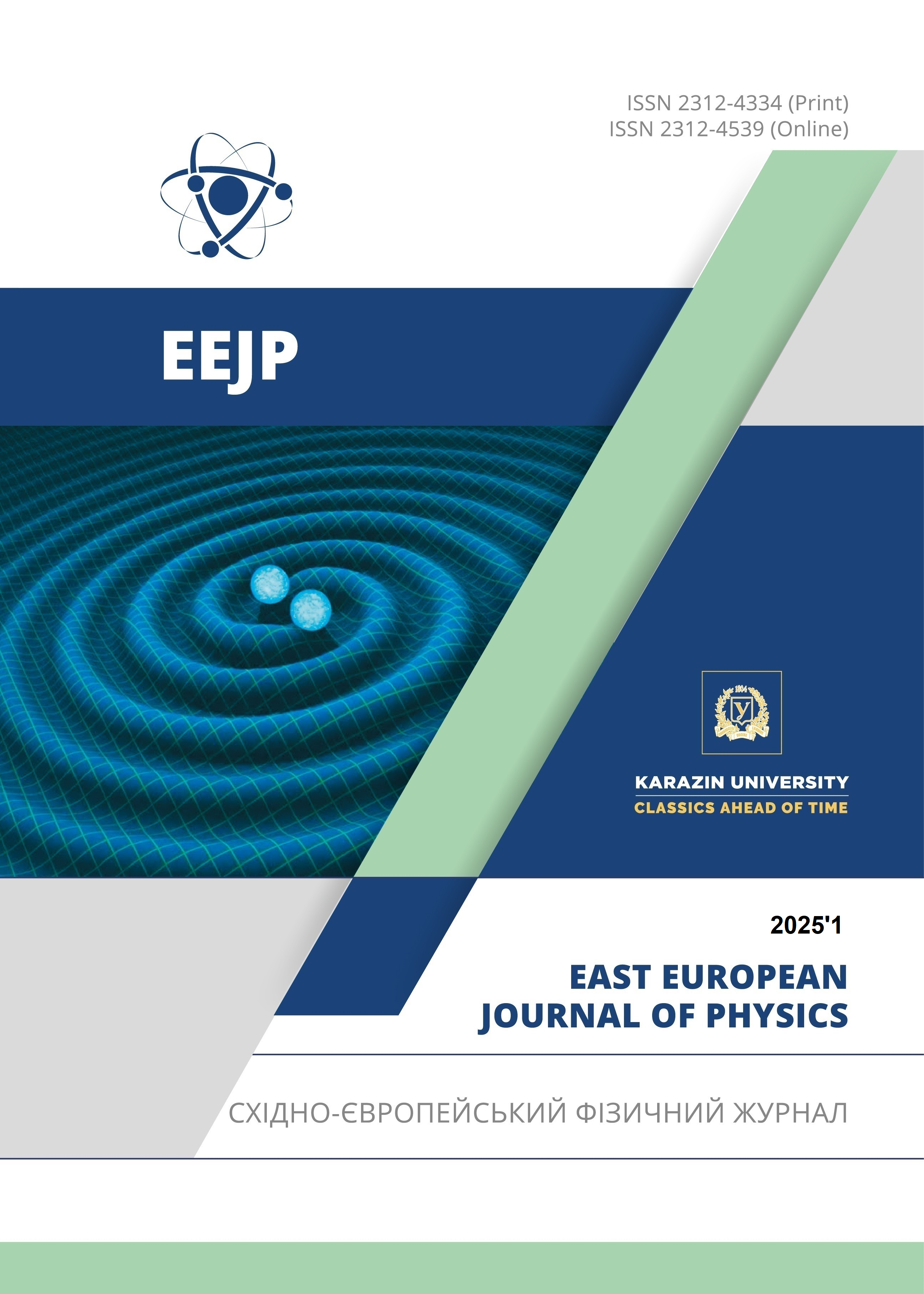Узагальнена Ghost Pilgrims космологічна модель темної енергії Б’янчі типу VI0 в теорії гравітації Саеза-Баллестера
Анотація
Узагальнена Ghost Pilgrim темна енергія (GGPDE) у теорії гравітації Саеза-Баллестера (SBTG) і просторово-часова структура VI0 типу Бьянчі слугують основою для цієї роботи. Ми використали просту параметризацію середнього масштабного коефіцієнта a(t) = exp{(αt+β)p} Мішри та Дуа [Astrophys. Space Sci. 366, 6 (2021)], щоб знайти точні розв’язки рівнянь поля. Ми вивчили GGPDE і темну матерію (DM), як коли вони взаємодіють, так і коли вони не взаємодіють. Для обох моделей виробляються деякі важливі та добре відомі параметри, включаючи параметр Хаббла, параметр рівняння стану (EOS), параметр уповільнення тощо. Виявлено, що для обох моделей параметр уповільнення означає прискорену фазу, а параметр EOS — космологічну константу. Як для невзаємодіючих, так і для взаємодіючих моделей досліджуються аналіз стабільності та енергетичні умови.
Завантаження
Посилання
R.K. Mishra, and H. Dua, “Evolution of FLRW universe in Brans-Dicke gravity theory,” Astrophys. Space Sci. 366, 6 (2021). https://doi.org/10.1007/s10509-020-03908-0
A.G. Riess, et al., “Observational Evidence from Supernovae for an Accelerating Universe and a Cosmological Constant,” Astron. J. 116, 1009–1038 (1998). https://doi.org/10.1086/300499
D.N. Spergel, et al., “First Year Wilkinson Microwave Anisotropy Probe (WMAP) Observations: Determination of Cosmological Parameters,” Astrophys. J. Suppl. Ser. 148, 175–194 (2003). https://doi.org/10.1086/377226
M. Tegmark, et al., “Cosmological parameters from SDSS and WMAP,” Phys. Rev. D, 69, 10350 (2004); S. Weinberg, “The cosmological constant problem,” Rev. Mod. Phys. 61, 103501 (1989). https://doi.org/10.1103/PhysRevD.69.103501
S. Weinberg, “The cosmological constant problem,” Rev. Mod. Phys. 61, 1 (1989). https://doi.org/10.1103/RevModPhys.61.1
P. Steinhardt, L. Wang, and I. Zlatev, “Cosmological tracking solutions,” Phys. Rev. D, 59, 123504 (1999). https://doi.org/10.1103/PhysRevD.59.123504
R.R. Caldwell, “A phantom menace? Cosmological consequences of a dark energy component with super-negative equation of state,” Phys. Lett. B, 545, 23-29 (2002). https://doi.org/10.1016/S0370-2693(02)02589-3
S. Noijiri, S.D. Odintsov, and S. Tsujikawa, “Properties of singularities in the (phantom) dark energy universe,” Phys. Rev. D, 71, 063004 (2005). https://doi.org/10.1103/PhysRevD.71.063004
T. Padmanabhan, “Accelerated expansion of the universe driven by tachyonic matter,” Phys. Rev. D, 66, 021301(R) (2002). https://doi.org/10.1103/PhysRevD.66.021301
M. Gasperini, F. Piazza, and G. Veneziano, “Quintessence as a runaway dilaton,” Phys. Rev. D, 65, 023508 (2001). https://doi.org/10.1103/PhysRevD.65.023508
F.R. Urban, and A.R. Zhitnitsky, “The cosmological constant from the QCD Veneziano ghost,” Phys. Lett. B, 688(1), 9–12 (2010). https://doi.org/10.1016/j.physletb.2010.03.080
N. Ohta, “Dark energy and QCD ghost,” Phys. Lett. B, 695, 41-44 (2011). https://doi.org/10.1016/j.physletb.2010.11.044
R.G. Cai, Z.L. Tuo, H.B. Zhang, and Q. Su, “Notes on ghost dark energy,” Phys. Rev. D, 84(12), 123501 (2011). https://doi.org/10.1103/PhysRevD.84.123501
A.R. Zhitnitsky, “Gauge fields and ghosts in Rindler space,” Phys. Rev. D, 82(10), 103520 (2010). https://doi.org/10.1103/PhysRevD.82.103520
B. Holdom, “From confinement to dark energy,” Phys. Lett. B, 697(4), 351–356 (2011). https://doi.org/10.1016/j.physletb.2011.02.024
A.R. Zhitnitsky, “Contact Term, its Holographic Description in QCD and Dark Energy,” arXiv:1112.3365[hep-ph], Phys. Rev. D, 86, 045026 (1988). https://doi.org/10.1103/PhysRevD.86.045026
M. Maggiore, L. Hollenstein, M. Jaccard, and E. Mitsou, “Early dark energy from zero-point quantum fluctuations,” Phys. Lett. B, 704(3), 102-107 (2011). https://doi.org/10.1016/j.physletb.2011.09.010
R.G. Cai, Z.L. Tuo, Y.B. Wu, and Y.Y. Zhao, “More on QCD Ghost Dark Energy,” arXiv:1201.2494v2[astro-ph.CO], Phys. Rev. D, 86, 023511 (2012). https://doi.org/10.1103/PhysRevD.86.023511
H. Wei, “Pilgrim Dark Energy,” arXiv: 1204.4032v3[gr-qc], Class. Quantum Grav. 29, 175008 (2012). https://doi.org/10.1088/0264-9381/29/17/175008
M. Sharif, and A. Jawad, “Analysis of generalized ghost version of pilgrim dark energy,” Astrophys. Space Sci. 351, 321-328 (2014). https://doi.org/10.1007/s10509-014-1833-y
M.V. Santhi, V.U.M. Rao, and Y. Aditya, “Anisotropic Generalized Ghost Pilgrim Dark Energy Model in General Relativity,” Int. J. Theor. Phys. 56, 362-371 (2017). https://doi.org/10.1007/s10773-016-3175-8
A. Jawad, “Analysis of Generalized Ghost Pilgrim Dark Energy in Non-flat FRW Universe,” arXiv: 1412.4000v1[gr-qc], Eur. Phys. J. C, 74, 3215 (2014). https://doi.org/10.1140/epjc/s10052-014-3215-6
P. Garg, A. Dixit, and A. Pradhan, “Cosmological models of generalized ghost pilgrim dark energy (GGPDE) in the gravitation theory of Saez-Ballester,” arXiv: 2004.11153v1[physics. gen-ph], International Journal of Geometric Methods in Modern Physics, 18(14), 2150221 (2020). https://doi.org/10.1142/S0219887821502212
R. Bali, and P. Kumari, “Bianchi Type VI0 inflationary universe with constant declaration parameter and flat potential in General Relativity,” Advances in Astrophysics, 2(2), 67-72 (2017). https://dx.doi.org/10.22606/adap.2017.22001
G.G. Luciano, “Saez–Ballester gravity in Kantowski–Sachs Universe: A new reconstruction paradigm for Barrow Holographic Dark Energy,” Physics of the Dark Universe, 41, 101237 (2023). https://doi.org/10.1016/j.dark.2023.101237
T. Vinutha, and K.V. Vasavi, “The study of accelerating DE models in Saez–Ballester theory of gravitation,” Eur. Phys. J. Plus, 137, 1294 (2022). https://doi.org/10.1140/epjp/s13360-022-03477-x
H. Wei, and R.G. Cai, “Interacting agegraphic dark energy,” Eur. Phys. J. C, 59, 99-105 (2009). https://doi.org/10.1140/epjc/s10052-008-0799-8
K.S. Adhav, “LRS Bianchi Type-I universe with anisotropic dark energy in lyra geometry,” Int. J. Astron. Astrophys. 1(4), 204 209 (2011). http://dx.doi.org/10.4236/ijaa.2011.14026
Y.S. Myung, “Instability of holographic dark energy models. Phys. Lett. B, 652, 223-227 (2007). https://doi.org/10.1016/j.physletb.2007.07.033
Авторське право (c) 2025 Теннеті Рампрасад, М.П.В.В. Бхаскара Рао, М. Кіран, Сатьянараяна Бора

Цю роботу ліцензовано за Міжнародня ліцензія Creative Commons Attribution 4.0.
Автори, які публікуються у цьому журналі, погоджуються з наступними умовами:
- Автори залишають за собою право на авторство своєї роботи та передають журналу право першої публікації цієї роботи на умовах ліцензії Creative Commons Attribution License, котра дозволяє іншим особам вільно розповсюджувати опубліковану роботу з обов'язковим посиланням на авторів оригінальної роботи та першу публікацію роботи у цьому журналі.
- Автори мають право укладати самостійні додаткові угоди щодо неексклюзивного розповсюдження роботи у тому вигляді, в якому вона була опублікована цим журналом (наприклад, розміщувати роботу в електронному сховищі установи або публікувати у складі монографії), за умови збереження посилання на першу публікацію роботи у цьому журналі.
- Політика журналу дозволяє і заохочує розміщення авторами в мережі Інтернет (наприклад, у сховищах установ або на особистих веб-сайтах) рукопису роботи, як до подання цього рукопису до редакції, так і під час його редакційного опрацювання, оскільки це сприяє виникненню продуктивної наукової дискусії та позитивно позначається на оперативності та динаміці цитування опублікованої роботи (див. The Effect of Open Access).








